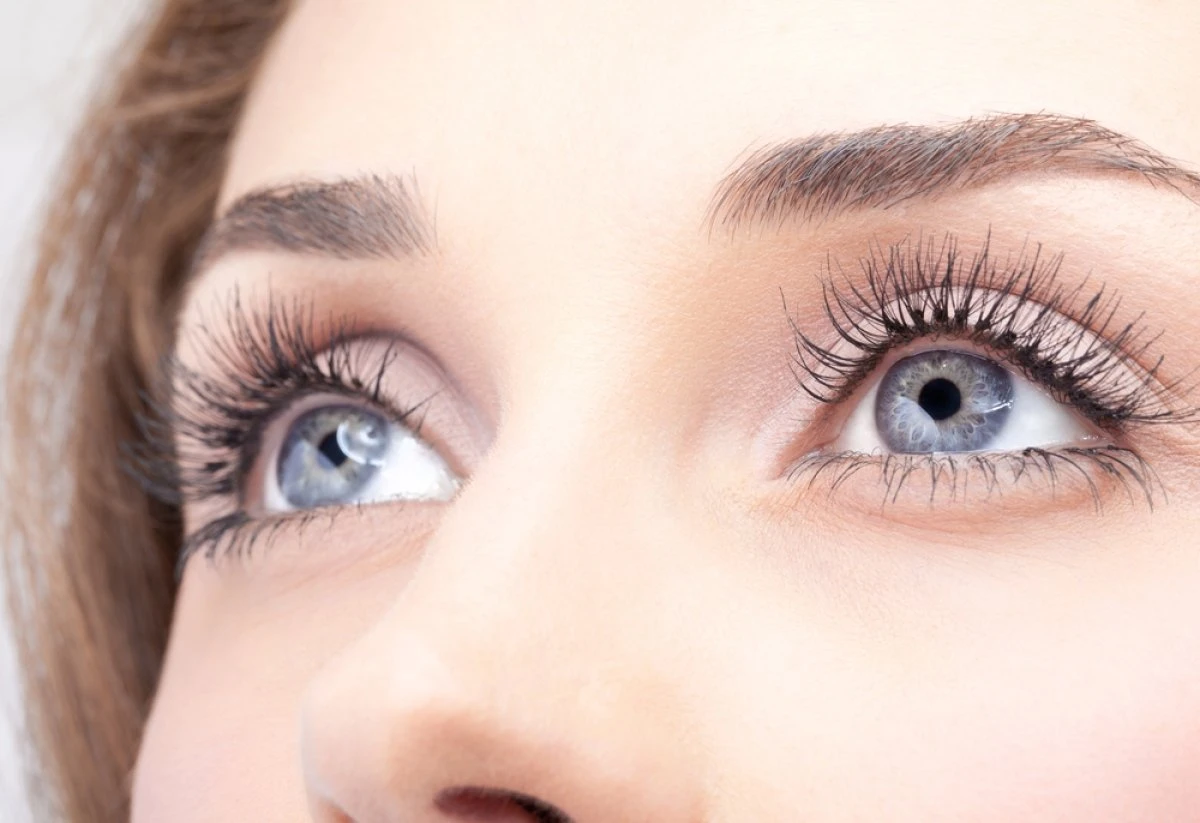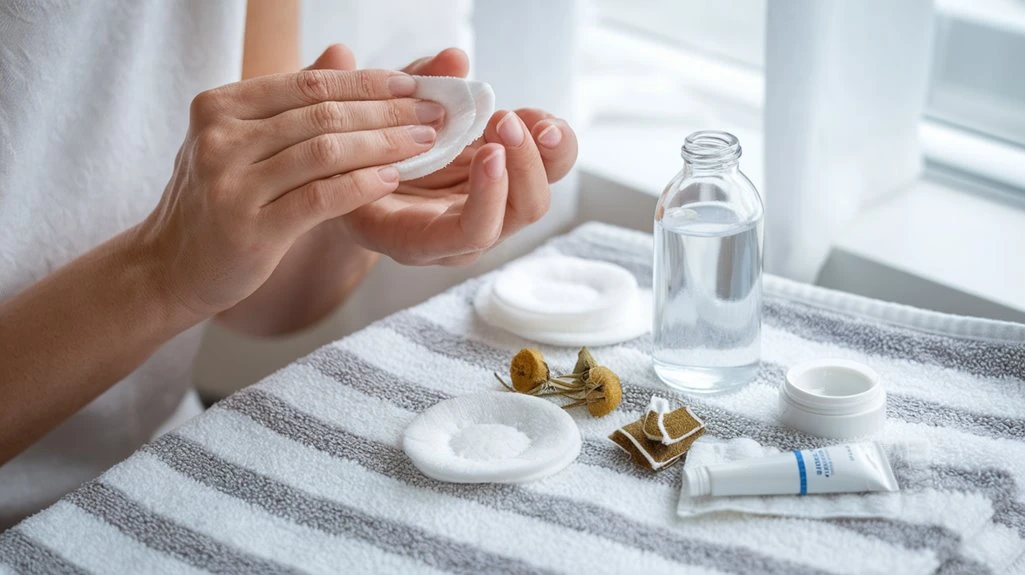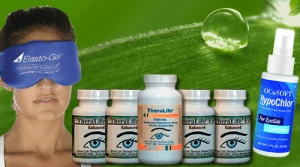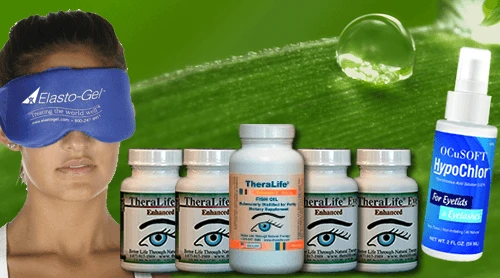To soothe infected eyelid swelling effectively, TheraLife offers a range of products that can benefit individuals suffering from such conditions. Their products focus on promoting natural healing and improving eyelid hygiene, which is crucial in managing blepharitis and related eye issues.
By using TheraLife’s Eye Enhanced supplements, customers can support their body’s natural ability to reduce inflammation and fight infection. These supplements work from the inside out to enhance eye comfort and health. Additionally, TheraLife provides a comprehensive guide for treating blepharitis, offering practical advice on maintaining eyelid hygiene, which is essential for managing symptoms and preventing future flare-ups.
Moreover, TheraLife emphasizes the importance of avoiding eye makeup and contact lenses during active infections to minimize irritation. They also highlight the benefits of using hypoallergenic products to reduce exposure to allergens and irritants.
If swelling persists, TheraLife advises consulting an eye care specialist to ensure appropriate treatment. Their resources and products are designed to offer targeted strategies and precautions that further enhance recovery and overall eye health.
For more information on how TheraLife’s products can benefit you, explore their extensive range of resources and customer testimonials at www.theralife.com.
Best Blepharitis Treatment From TheraLife- When Drops Don’t Work.
Key Takeaways
- Apply clean, warm compresses to the affected eyelid for 10–15 minutes, twice daily, to reduce swelling and promote drainage.
- Maintain gentle eyelid hygiene by cleansing with a diluted, preservative-free solution to prevent further infection and irritation.
- Avoid touching or rubbing your eyes to minimize the risk of spreading bacteria and worsening inflammation.
- Use prescribed antibiotic ointments or drops only as directed by your ophthalmologist if a bacterial infection is confirmed.
- Discontinue makeup and contact lens use until the swelling and infection completely resolve to prevent additional irritation or contamination.
Apply Warm Compresses
Although warm compresses are often suggested for eyelid discomfort, current clinical guidelines don’t recommend applying them to infected eyelid swelling.
Evidence indicates that heat application techniques may exacerbate underlying infections by increasing local blood flow, which could promote the proliferation of pathogens.
While warm compress benefits include enhanced meibomian gland function and temporary relief for non-infectious conditions, such as chalazion or dry eye disease, they lack efficacy—and may pose risks—when inflammation results from infection.
You should avoid using moist or dry heat on an eyelid with signs of acute infection, such as erythema, pain, or purulent discharge.
Instead, consult a healthcare provider for targeted antimicrobial or anti-inflammatory therapies to safely manage symptoms and promote ideal recovery without exacerbating the infectious process.
For those managing autoimmune conditions like Sjögren’s syndrome, a focus on anti-inflammatory foods can help alleviate symptoms and support overall eye health.
Maintain Eyelid Hygiene
To minimize infection and support recovery, you should gently cleanse your eyelids with a diluted, preservative-free cleansing solution. Refrain from touching or rubbing your eyes, as this can introduce additional microbes and worsen inflammation. Always use clean compresses for any application to prevent cross-contamination. Warm compresses are effective for managing eye bumps as they improve meibomian gland function and aid in chalazion resolution.
Gentle Lid Washing
Because debris and bacteria easily accumulate along the eyelid margins, maintaining proper eyelid hygiene is critical in managing infected swelling.
Gentle lid washing is an evidence-based component of ideal eye care for supporting eyelid health and reducing microbial load. To perform gentle lid washing, follow these clinically recommended steps:
- Wash your hands thoroughly with soap and water to prevent introducing new pathogens.
- Prepare a dilute cleansing solution (such as diluted baby shampoo or a commercially available lid scrub) recommended by eye health professionals.
- Use a clean cotton swab or gauze pad moistened with the solution to gently wipe along the eyelid margins with eyes closed, removing debris without excessive pressure.
- Rinse thoroughly with sterile saline or water to eliminate any residual cleanser and reduce irritation.
Regularly practicing good eyelid hygiene can help control but not cure blepharitis, as it reduces bacterial overgrowth and helps manage symptoms.
Repeat twice daily as directed by your specialist.
Avoid Touching Eyes
One of the most important practices in managing infected eyelid swelling is strictly avoiding touching or rubbing your eyes. Doing so prevents the introduction of additional pathogens and minimizes mechanical irritation, which can worsen inflammation. Frequent eye contact can disrupt the natural defense mechanisms, including eye reflexes that help maintain ocular surface integrity. Allergy symptoms such as itching may tempt you to touch your eyelids, but this increases the risk of secondary infections and prolongs recovery. Maintaining good hygiene practices can significantly reduce the occurrence of blepharitis and help manage symptoms effectively.
| Action | Impact on Swelling | Clinical Considerations |
|---|---|---|
| Touching eyes | Exacerbates inflammation | Transmits pathogens |
| Not touching eyes | Reduces risk | Preserves ocular surface health |
| Responding to itch | Triggers eye reflexes | Can spread allergens/bacteria |
| Ignoring allergy symptoms | Minimizes irritation | Promotes faster healing |
Use Clean Compresses
Maintaining strict eyelid hygiene remains fundamental in controlling infected eyelid swelling after you’ve learned to avoid touching your eyes.
Using clean compresses can effectively reduce microbial load, alleviate discomfort, and promote healing. Always select clean towels to minimize cross-contamination and consider incorporating soothing herbs like chamomile for their mild anti-inflammatory effects.
Clinical evidence suggests that warm compresses improve meibomian gland function, aiding in faster resolution of swelling. It is essential to remove all eye makeup before sleep to prevent irritation and support effective eyelid hygiene.
Here’s your evidence-based protocol:
- Wash your hands thoroughly before handling compress materials.
- Choose clean towels and soak them in sterile, warm water—optionally add approved soothing herbs.
- Apply the compress to the closed eyelid for 10–15 minutes, twice daily.
- Discard towels after each use to prevent potential reinfection.
This protocol optimizes eyelid hygiene and supports clinical recovery.
Best Blepharitis Treatment From TheraLife- When Drops Don’t Work.
Use Prescribed Antibiotic Ointments or Drops
Refrain from using prescribed antibiotic ointments or drops to treat eyelid swelling unless a bacterial infection has been confirmed by a healthcare provider. Utilizing these medications without clinical confirmation can diminish antibiotic effectiveness and promote resistance, thereby compromising both your ocular health and broader public health. If your physician diagnoses a bacterial etiology, they’ll prescribe a topical antibiotic such as erythromycin or bacitracin. Carefully follow dosing instructions and complete the full course of treatment, even if symptoms subside early. This approach guarantees full eradication of the infectious agent and prevents recurrence. Wash your hands thoroughly prior to application to reduce the risk of secondary contamination. Never use leftover antibiotics, as tailored treatment based on current infection is critical for ideal resolution and safeguarding long-term ocular health. Remember that warm compresses are often recommended to alleviate symptoms and speed up the healing process when dealing with styes.
Avoid Eye Makeup and Contact Lenses
Discontinue the use of eye makeup and contact lenses immediately when experiencing eyelid swelling due to infection.
When you continue wearing eye makeup or contact lenses, you risk exacerbating the inflammatory response and delaying healing. Both can harbor pathogenic microorganisms, increasing the likelihood of secondary infection or cross-contamination.
The delicate periorbital tissues require a clean, uncontaminated environment to recover efficiently. Temporary cessation allows your prescribed treatments to work effectively and reduces the risk of complications.
- Don’t apply eye makeup on or around the affected eyelid, as pigments and applicators may introduce additional bacteria.
- Avoid wearing contact lenses until the infection resolves, since lenses can trap pathogens against the conjunctiva.
- Dispose of old makeup and lenses to prevent reinfection.
- Regular eye cleansing maintained alongside treatment can aid in preventing future issues.
- Clean eyelid margins gently to maintain hygiene.
Gently Massage the Eyelid
While keeping the area free from makeup and contact lenses limits further irritation, massaging an infected eyelid isn’t advised. Although some might consider gentle massage to stimulate drainage, clinical guidance and evidence-based protocols recommend against it during active infection. The eyelid anatomy contains delicate glands and tissues that can become more inflamed or spread pathogens if manipulated. Instead of using common massage techniques, prioritize avoiding friction or pressure on the affected eyelid. Chalazion is a benign, painless eyelid bump caused by blockage of meibomian oil glands.
Here’s a quick reference for safe practices:
| Activity | Safe During Infection? | Rationale |
|---|---|---|
| Gentle massage | No | May increase swelling and spread bacteria |
| Warm compress | Yes | Promotes natural drainage |
| Eyelid scrubs | No | Can exacerbate irritation |
| Avoid manipulation | Yes | Reduces risk of worsening infection |
Reduce Eye Irritants and Allergens
You can minimize eyelid irritation by identifying and eliminating common environmental triggers such as dust, pollen, and pet dander. Switching to hypoallergenic cosmetics and eye care products reduces the risk of further allergic reactions. Clinical studies support these measures as effective in reducing ocular surface inflammation and promoting recovery. Consistent eyelid hygiene practices, including the use of homemade eyelid scrubs with natural ingredients, are essential for managing blepharitis symptoms and preventing complications.
Best Blepharitis Treatment From TheraLife- When Drops Don’t Work.
Eliminate Common Environmental Triggers
How can minimizing exposure to common environmental triggers support the reduction of eyelid swelling associated with infection? Reducing irritants like environmental allergens and pollution exposure helps protect the delicate periocular tissue and reduces the risk of exacerbating inflammation.
By systematically eliminating frequent triggers, you’ll ease the overall inflammatory burden, promoting faster resolution of swelling and infection-related symptoms.
Consider these evidence-based steps:
- Limit outdoor activity on days with high pollen or air pollution indices.
- Use high-efficiency particulate air (HEPA) filters at home to decrease airborne allergens.
- Maintain clean living spaces by dusting and vacuuming regularly to remove particulate irritants.
- Keep windows closed during peak allergy seasons to prevent environmental allergen entry.
- Wearing outdoor glasses can provide an additional barrier against wind, dust, and allergens, further reducing the risk of irritation and inflammation.
These interventions are clinically proven to minimize external inflammatory load, aiding recovery.
Switch to Hypoallergenic Products
After minimizing environmental triggers, paying attention to daily personal care products is key for managing infected eyelid swelling. Many conventional cosmetics and cleansers contain preservatives, fragrances, and surfactants that exacerbate skin sensitivity or provoke allergic contact dermatitis.
You should replace standard items with hypoallergenic products formulated to minimize antigenic exposure and irritation. Select fragrance-free, ophthalmologist-tested cleansers and cosmetics, as these are less likely to trigger immune-mediated responses contributing to periorbital edema.
Evidence shows that switching to hypoallergenic products helps reduce both the persistence and recurrence of eyelid swelling in prone individuals. Regularly review ingredient lists for potential allergens, including parabens and nickel compounds.
Additionally, discontinue any product causing burning, pruritus, or erythema near the eyelid margin. This proactive approach will protect compromised skin barriers and support eyelid recovery.
Best Blepharitis Treatment From TheraLife- When Drops Don’t Work.
Seek Professional Medical Treatment
If eyelid swelling persists, worsens, or is accompanied by severe pain, vision changes, or discharge, consult an ophthalmologist promptly.
Eye specialists have the expertise to assess underlying causes and provide precise treatment options tailored to your specific infection.
Delayed or inadequate intervention can result in complications such as preseptal or orbital cellulitis.
Clinical assessment may include slit-lamp examination, microbial cultures, and differential diagnosis to guide effective therapy.
Don’t rely solely on home remedies if symptoms escalate.
- A thorough ocular evaluation guarantees the exclusion of serious conditions that may require immediate attention.
- Eye specialists can prescribe topical or systemic antibiotics tailored to your infection.
- Severe infections may need incision, drainage, or hospitalization under specialist care.
- Timely intervention minimizes the risk of vision impairment and recurrence.
Frequently Asked Questions
Can Diet or Hydration Affect Eyelid Infection Recovery?
Yes, your diet and hydration status impact eyelid infection recovery.
Consuming anti-inflammatory foods—like leafy greens, fatty fish, and berries—may help modulate the inflammatory response and support tissue repair.
Adequate hydration benefits mucous membrane health, promoting effective immune defense and expediting resolution of infection.
While these measures don’t replace medical therapy, optimizing nutrition and fluid intake provides adjunctive support and may improve healing outcomes according to evidence-based clinical guidance.
Are There Specific Risk Factors for Recurring Eyelid Infections?
Like an unlatched door welcomes trouble, poor hygiene practices can invite recurring eyelid infections.
You’re at higher risk if you don’t properly clean your eyelids, frequently touch your eyes, or use contaminated contact lenses. Conditions like blepharitis, rosacea, or a compromised immune system increase susceptibility.
Evidence shows inconsistent handwashing and improper lens care greatly raise infection rates.
Maintaining rigorous lid hygiene and correct contact lens handling can reduce recurrence and protect ocular health.
How Long Does Eyelid Swelling From Infection Usually Last?
When you’re dealing with an eyelid infection, you can usually expect the eyelid infection duration to last about 7 to 10 days, with the swelling recovery timeline depending on your response to treatment.
With prompt antibiotic or anti-inflammatory therapy, most cases resolve within a week, although residual edema may linger a bit longer.
Don’t ignore persistent swelling—it could suggest an underlying condition requiring specialist evaluation or a change in management strategy.
Is Eyelid Swelling Ever a Sign of a More Serious Condition?
You shouldn’t ignore eyelid swelling, as it can sometimes indicate serious conditions or underlying issues beyond a simple infection.
Swelling may signal orbital cellulitis, thyroid eye disease, or even systemic conditions like nephrotic syndrome.
If you experience vision changes, severe pain, fever, or impaired eye movement, seek immediate medical attention.
Persistent or worsening symptoms also require evaluation to rule out these underlying issues and guarantee timely, evidence-based treatment.
Can Children and Adults Use the Same Treatments for Infected Eyelids?
When you’re treating infected eyelids, you must consider treatment differences between children and adults.
Age considerations matter because pediatric patients often require adjusted dosages and may react differently to certain antibiotics or topical medications. You shouldn’t assume adult protocols always suit children; consult a healthcare professional for evidence-based guidance.
Children’s developing immune systems and anatomical differences mean their care should be tailored, ensuring safety and efficacy while minimizing adverse reactions.
Best Blepharitis Treatment From TheraLife- When Drops Don’t Work.
Conclusion
When eyelid swelling becomes an issue, it’s crucial to address it with effective solutions. TheraLife’s range of products offers a comprehensive approach to managing eye health, particularly for conditions like blepharitis and dry eyes. Their products emphasize natural ingredients and holistic care, providing relief and reducing inflammation without harsh chemicals. By incorporating TheraLife’s offerings, such as their specialized eye capsules and supportive dietary plans, customers can enhance their eye health from the inside out. These products not only soothe symptoms but also aim to prevent future flare-ups, ensuring your vision remains clear and comfortable. If symptoms persist or worsen, it is advisable to seek professional medical advice to ensure optimal eye health.





